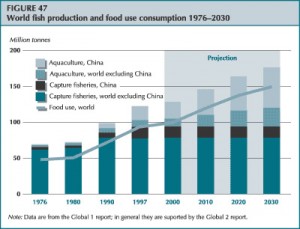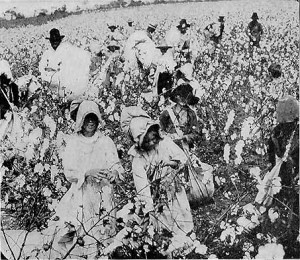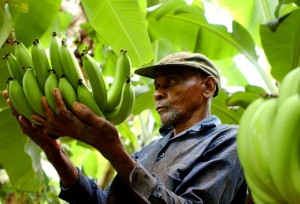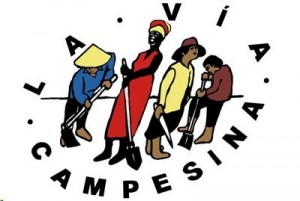
All people are still dependent on natural resources, but centuries of development complete with urbanization and globalization have removed a large proportion of the world’s population from the production of those natural resources both physically and psychologically. Take, for example, a New York City investment banker. He gets up in the morning, puts on his suit, grabs his coffee and bagel to go, and takes the subway to work where he will trade shares of largely transnational companies. However, each step of his day is connected to and supported by a network of natural resource-based communities: one in India that grew and spun his suit, one in Columbia that grew his coffee, one in North Dakota that grew the wheat for his bagel, and countless others that produce the raw materials for the company he trades. This process of separation means that natural resource dependent communities face both forces of marginalization and empowerment.
Marginalization
Communities dependent on natural resources in modern society face a number of challenges, many of which have been created or worsened through the process of globalization. The phenomenon has been called “the resource curse”, originally coined by Sachs and Warner in 1995, who documented that one standard deviation increase in the ratio of natural resource exports to gross national product is associated with a decrease of just over 1% in the growth rate. Each community is in a unique historical, postcolonial, and ecological context, but there are a few shared challenges to natural resource dependent communities worldwide that contribute to the resource curse: a) competition on the global marketplace, b) poverty, c) decision-making power elsewhere, and d) portrayal as ‘backward’ or undeveloped.

Perhaps the most notable trait of globalization is the emergence of a global marketplace. A unified market, however, also means a unification of prices reflected global demand rather than the cost of production. As a result, production is expected to move to the places where it can be done affordably and regions or communities choose what to produce based on what they can achieve on the global marketplace. For example, subsidies to industrial corn farmers in the United States increased the total production of worldwide corn and dropped the price. Farmers in Mexico then lost their maize farms due to an inability to compete with cheap, imported US corn and instead replaced their crops with labor-intensive fruits and vegetables that require cheap labor to stay competitive (McMichael 2004). Industrialization of aquaculture faces a similar fate in the new “blue revolution”. Countries with lax environmental regulations converting mangroves and wetlands into shrimp and fish farms are overwhelming the market with fish sold below a price that will support a fisher harvesting wild fish (Mansfield 2010). In addition, these are not even the same species competing on the world market – consumers do not seem to differentiate between types of fish or mode of production.
As a consequence of the global market, resource dependent communities tend to be poor compared to urban areas in the same countries. Peluso et al (1994) describe four main reasons such communities are often poor. The first is that their economic structure tends to be focused on one extractive resource, often governed by a single company. This structure not only leaves the community vulnerable to natural fluctuations in that resource (like pest outbreaks in a crop or climactic fluctuations in fish stock), but leaves community members in the control of corporate leadership. Second, the resource may be of poor quality, especially when compared to global offerings of the same product. This may be because of temporal changes in the land/seascape’s ability to produce or because resource dependent communities have seen themselves pushed on to more marginal land or sea over time. Third, the production of natural resources has shifted from many independent producers to a concentrated ownership of land and capital, increasing inequality in the community. Lastly, production of natural resources has followed many other industries in substituting capital and technology for labor, which eliminates the total number of workers needed.

In the international arena, postcolonial legacies are often invoked when explaining poverty in resource-dependent areas. Many communities use their natural resource endowment as an employment of last resort (Baland and Platteau 1996). After colonial nations became independent, they were left with their natural resources but removed from the industry necessary for processing them. Due to international aid policies driven largely by the World Bank and International Monetary Fund, these regions were never afforded the capital to develop these needed industries for themselves, therefore remain dependent on the companies in other countries to purchase their raw goods. However, raw materials command the least profit in most commodity chains, so communities are unlikely to be able to change their market position without outside help (McMichael 2004).
Corporate leadership and political structures usually exist in cities, away from the production of the raw materials. Therefore, the decision-making boundaries are determined outside of the resource producing community. In his study of the Wise Use land movement in the American rural west, McCarthy (2002) noted that the desires of the rural communities were threatened to be overtaken by state entitlements and larger market priorities. Blaikie and Brookfield (1987) noted “it is therefore very common to find that direct decision making is frequently local, for example, the manager of a sugar plantation or the peasant farm household, but many of the parameters of choice are determined by others, for instance locally by the landlord, centrally by corporate management of a group of plantations, or nationally by government parastatal boards”(p.69). Therefore, it is difficult for local communities to set the political agenda to benefit themselves. Another study in Guinea determined “natural resource management and vegetation enhancement in this region depend less on community-level authorities and socio-cultural organizations than on the sum of a much more diffuse set of relations”(p.236) (Fairhead and Leach 1996).
Resource-dependent communities often bring about visions of historic ways of life and make apparent the connections between human society and nature. However, this connection is used to portray people in these areas as uneducated, backward, and undeveloped. Their knowledge is generally practical and learned by experience rather than in the language of policymakers or academia, making it easier to dismiss (Berkes 2008). It may also be embedded in religion or magic in addition to science, adding to the ease in which their knowledge and insights may be dismissed at higher levels of governance (Nader 1996). Although there is widening recognition that communities have much to offer conservation efforts, often these communities are portrayed as profit-driven or bound by the need to fulfill basic necessities like food and water. For instance, in his study of Sahelian pastoralism, Turner found that pastoralists were viewed as tradition-bound people solely interested in stock growth and portrayed as ecological villains (Zimmerer and Bassett 2003). In reality, the long-term relation to the land had allowed the pastoralists to increase the number of cattle in the herd by following particular grazing patterns.
Empowerment
Globalization does not bring all negatives to the community, however. The globalization process directly connects communities to world markets, international non-governmental organizations, and international financing. This connection gives the opportunity to communities to bypass state power and increase the relative importance of the local. Strengthening of local identity in the face of globalizing forces manifests itself in increased demand for indigenous language education, increased production of cultural festivals, and increased support for ethnic music. These efforts all take place through the realization of the importance of cultural diversity. Three processes that support the local have emerged through the globalization process: a) direct challenges to state power, b) “glocalization”, and c) the rise of alternatives.

Recognition by citizens that nationally-produced management was not necessarily locally relevant or effective has led to local ingenuity. For instance, state misinterpretation of ecological effects in the forest-savanna border led managers to produce policies against land degradation; however, instead of forest converting to savanna as assumed, villagers were maintaining the reverse dynamic. “That these problematic interactions have not had a more degrading effect on vegetation is owed at least partly to the effective resistance strategies which villagers developed” (Fairhead and Leach 1996 p.260). In another example, fair trade banana cooperatives in Equador were able to bypass state-sanctioned Dole distribution and participate directly in the global market. This enabled farmers to recover the cost of cropping and make a livable wage (Shreck 2002).
Globalization has been far from conflict-free. Escobar (2004) describes two sides of the globalization process. The first is the “economic-military-ideological” order that heightens already present marginalization and suppression of local knowledge and culture. The second balancing force is the emergence of self-organizing social movement networks to counter globalization and engage in the politics of difference. Colloquially, this second process has been termed “glocalization”. The movements are in direct response to the perceived problems with globalization. Escobar describes these movements as being place-based and locally motivated but tied into transnational networks for support. For example, struggles for water sovereignty in Bolivia were aided by international efforts for indigenous rights that succeeded in electing Bolivia’s first indigenous president. His administration was quick to nationalize utilities and prioritize Bolivian needs even though that meant withdrawing from the global market (Swyngedouw 2004).
The global capitalist market also has a similar countermovement occurring, creating a rise in the existence of alternatives. For example, the World Bank has realized through Grameen Bank microcredit loans that investments made at the community level for small-scale, cooperative entrepreneurship are more effective than programs meant to enter communities into the global marketplace (McMichael 2004). They work through small loans to small groups of women to start a business in their communities. The reason they chose women is because women have been shown to more reliably invest profits back into the community.
 Food plays a particularly important role in the search for alternatives because of the direct physical need for food. McMichael (2004) entitles alternative movement “food sovereignty”, which means not only protecting local farming but protecting the rights of people to define their own land and water policies, explicitly recognizing the link between cultural and ecological diversity. He cites the Brazilian chapter of Via Campesina, whose rallying call of “Occupy! Resist! Produce!” lead to government recognition of seized lands (largely by dispossessed farmers) under cooperative production that included community development projects. The issue becomes more complicated, however, when one realizes that there is still an expectation of local food even in a largely globalized food market. In a survey of seafood consumers in North Carolina, 89% expressed demand and expectation for local seafood (Andreatta and Parlier 2010), largely unaware of the prominence of imported seafood even in a coastal state. Their main reason was for taste, just above community development. Food is still largely seen as a community entity.
Food plays a particularly important role in the search for alternatives because of the direct physical need for food. McMichael (2004) entitles alternative movement “food sovereignty”, which means not only protecting local farming but protecting the rights of people to define their own land and water policies, explicitly recognizing the link between cultural and ecological diversity. He cites the Brazilian chapter of Via Campesina, whose rallying call of “Occupy! Resist! Produce!” lead to government recognition of seized lands (largely by dispossessed farmers) under cooperative production that included community development projects. The issue becomes more complicated, however, when one realizes that there is still an expectation of local food even in a largely globalized food market. In a survey of seafood consumers in North Carolina, 89% expressed demand and expectation for local seafood (Andreatta and Parlier 2010), largely unaware of the prominence of imported seafood even in a coastal state. Their main reason was for taste, just above community development. Food is still largely seen as a community entity.
The local food movement has produced yet another kind of alternative – the community supported agriculture and fishery programs. These programs largely represent a desire for people to connect to their food producers and support members of their community. Paired with farmer’s markets, they provide an outlet for direct marketing so that farmers and fishers make all the profits on their product. Patrons largely site the availability of fresh food and face-to-face contact with the producers as reasons to visit farmer’s markets or join a CSA (Schnell 2007). This contact builds community and respect for food producers, “putting a face on food” rather than distancing consumers like globalization has done.
Selected Resources:
McMichael, P. (2004). Development and social change: A global perspective, Pine Forge Pr.
Mansfield, B. (2010). Is Fish Health Food or Poison? Farmed Fish and the Material Production of Un/Healthy Nature Antipode DOI: 10.1111/j.1467-8330.2010.00743.x
Peluso, N., Humphrey, C., & Fortmann, L. (1994). The rock, the beach, and the tidal pool: People and poverty in natural resource-dependent areas Society & Natural Resources, 7 (1), 23-38 DOI: 10.1080/08941929409380842
Carter, N., Baland, J., & Platteau, J. (1996). Halting Degradation of Natural Resources: Is There a Role for Rural Communities? International Affairs (Royal Institute of International Affairs 1944-), 72 (4) DOI: 10.2307/2624181
McCarthy, J. (2002). First World political ecology: lessons from the Wise Use movement Environment and Planning A, 34 (7), 1281-1302 DOI: 10.1068/a3526
Fairhead, J. and M. Leach (1996). Misreading the African landscape: society and ecology in a forest-savanna mosaic, Cambridge Univ Pr.
